There’s a wide variety of microphones out there, each with its own strengths, weaknesses, and ideal use cases. For musicians and producers who want to record and create specific sounds, it’s important to understand these factors in order to achieve the palette of sounds you want, or simply get the most out of the microphones you have.
So, we’re covering the different types of microphones available, from different capsule designs to polar patterns, so you can use them effectively.
In a hurry?
At a glance, here are the many different kinds of mics, how they work, and our recommendations.
| Microphone Type/Polar Pattern | Description | Our Recommendation | |
|---|---|---|---|
| Type | Dynamic | Dynamic microphones are an early form of microphone design that uses a diaphragm to push a coil through a magnetic field. This creates a current through electromagnetic induction that follows the sound. Dynamics are less sensitive and great for loud sources. | Shure SM7dB |
| Condenser | Condensers use a metal diaphragm attached to a metal plate. Movement of the diaphragm changes the distance between the diaphragm and the plate, resulting in changing voltages due to capacitance. Condensers are more sensitive and more detailed. | Neumann TLM 102 | |
| Ribbon | Ribbons are a variant of dynamic microphones that use a long, pleated strip of thin metal for a diaphragm. This gets moved through a static magnetic field. Vibrations in the diaphragm create electrical charge. Ribbon mics sound natural, smooth, and dark, but their diaphragms are very delicate. | Coles 4038 | |
| Polar Pattern | Shotgun | Shotgun microphones can be either dynamic or condensers in a long, barrel-shaped form. They have an extremely directional, forward-facing polar pattern that has minimal pickup from the sides and rear and extends further towards the front. They are commonly used for broadcasting, film, and TV audio. | Rode Videomicro II |
| Cardioid | A polar pattern that is also described as unidirectional, cardioid picks up from the front, with some sensitivity at the sides, rejecting any sounds from the rear. | G4M Studio Condenser Microphone | |
| Supercardioid/Hypercardioid | A stronger form of cardioid polar pattern, supercardioid and hypercardioid pick up even less from the sides and slightly more from the rear. Hypercardioid is more extreme, whereas supercardioid is more in-between. | Audio Technica MB3K | |
| Omnidirectional | Omnidirectional is a polar pattern that picks up evenly from all directions: front, rear, and sides. It's great for capturing the feel of a space or multiple sound sources at once. | AKG Perception P420 | |
| Figure 8 | A polar pattern that picks up from the front and back evenly, but picks nothing up from the sides. It's ideal for creative stereo-recording techniques. | AKG C414 XLS | |
| Multi-Pattern | Multi-pattern microphones offer a range of selectable polar patterns. This could be just two or all of the previously mentioned patterns at once. | Universal Audio Sphere LX Modeling Microphone |
What is a microphone?
It might feel like stating the obvious, but how much do you really know about how a microphone works? Sure, you can point it at a sound to record it, but how does that actually happen?
A microphone is a type of electrical device commonly referred to as a transducer. Transducers are everywhere in audio; headphones, microphones, speakers, and even guitar pickups can fall into this category. Transducers take a certain kind of energy and change it into another, specifically in the case of microphones, from sound waves to an electrical current.
Different microphone designs achieve the same outcome in unique ways, but they all fundamentally use a diaphragm and some way of manipulating or creating electrical currents. This will happen from the sound waves hitting the diaphragm and creating some sort of movement.
The fact that the movement of the diaphragm directly affects the electrical current is crucial to capturing the sound we want to hear instead of just transmitting electrical noise.
Different types of microphones
Dynamic microphones
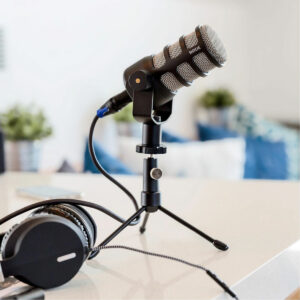 Dynamic microphones use electromagnetic induction to create an electrical current from sound waves. Electromagnetic induction uses a metal coil and a magnetic field, when the metal coil is moved through this magnetic field, it creates an electrical current through the coil.
Dynamic microphones use electromagnetic induction to create an electrical current from sound waves. Electromagnetic induction uses a metal coil and a magnetic field, when the metal coil is moved through this magnetic field, it creates an electrical current through the coil.
Taking great advantage of this principle, dynamic mics comprise a metal coil attached to a sturdy mylar diaphragm, which gets pushed through the magnetic field by the pressures of the air caused by the sound we want to record.
Dynamic microphones have a lower sensitivity, capable of taking more gain and louder sources without distorting. They often have less detail but can provide a very upfront, authoritative sound, especially in the lower frequencies.
This makes them great for vocals, especially intense performances, like rock and metal vocals or rapping; drums, such as snares, toms, and kick drums; guitar combo amps or cabs; and brass or woodwinds.
Dynamic mics, primarily vocal microphones such as the SubZero SZM-11, are commonly seen in live performances, but they can also be used to capture instruments. They’re great for musicians and producers working in untreated spaces since their lower sensitivity can prevent pickup of room noise.
The trade-off is that they don’t tend to recreate high-frequencies very well, which makes them unsuitable for really detailed instrument recordings. However, there are plenty of dynamics that can still keep pace in professional studios – it’s all about making the right choice of mic and good placement.
If you’re after a single mic to do many jobs at once in an untreated room, a dynamic microphone that’s good for both vocals and instruments is a good choice. Dynamics are also becoming popular with podcasters and online content creators, with mics like the Rode Podmic appearing in many popular Twitch streams, YouTube channels, and podcasts.
Condenser microphones
A condenser microphone uses a technique called electrostatics to create its current. In this design, there are two charged metal plates, one is fixed, and the other is the diaphragm, which is made out of extremely thin metal. As the diaphragm moves, the charge between the plates changes, and these changes make up our signal. This is called capacitance.
To charge the capacitor within the condenser element, we use phantom power. This also boosts our signal to audible levels and is necessary when working with condensers. Fortunately, most audio interfaces, mixers, or recording consoles can easily provide this. Or when working on live sets, perhaps an in-line phantom power box can serve as a more convenient source.
Condenser microphones are extremely sensitive and detailed and tend to have a full, rich sound. This makes them great for bringing out detail in vocals or instruments, like acoustic guitars, violins, cellos, or violas. A good condenser microphone will let any lead vocal take over the mix.
They’re capable of handling louder sources, too. You may see them on kick drums, drum overheads, or as room microphones to capture distance from a source, and I think they’re especially good when layered with a dynamic microphone on guitar amps.
They’re also best for clever stereo recordings if you want a more immersive effect. A good condenser can face just about anything, but proper placement can take time, experimentation, and a controlled environment to prevent a distorted signal or damaging the mic, so they’re generally better-suited as a studio tool. You will also sometimes see condensers on live stages for drum overheads or guitar amps.
Ribbon microphones
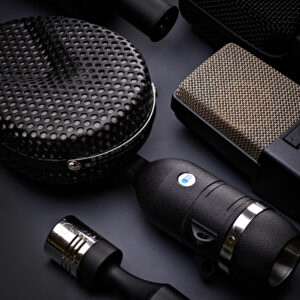 Ribbon microphones both predate and use a similar design to dynamic microphones. Whilst dynamic microphones were initially invented in 1897, the moving-coil designs we know wouldn’t become popular until significant improvements from engineers in 1931.
Ribbon microphones both predate and use a similar design to dynamic microphones. Whilst dynamic microphones were initially invented in 1897, the moving-coil designs we know wouldn’t become popular until significant improvements from engineers in 1931.
Throughout the 1920s to the 1940s, ribbon microphones were probably the most common type of microphone, since condenser microphones of the time had an extremely limited frequency response.
Using the same principle of electromagnetic induction in a slightly different way, ribbon microphones boast an extremely thin metal diaphragm that moves back and forth through a stationary magnetic field due to the movement of sound waves through the air.
This induces a current that’s directly proportional to the changes in air pressure caused by the sound source.
The resulting sound of ribbon microphones is rich, smooth, and slightly dark, with a gentle roll-off in high frequencies that matches the human ear well, making it feel very natural.
However, since the metal of the diaphragm is corrugated and extremely thin, it can easily break when subjected to loud sounds.
Ribbon microphones are great for smooth, retro-styled vocals and are extremely popular on guitar amps or cabs, drum overheads, and orchestral recordings. The Coles 4038 is particularly great for recording orchestral instruments, but the placement has to be carefully thought-out with high SPL sources.
Even high-gain guitar tones can sound great on ribbons, but they need to be placed much further away from the cabinet speakers to protect the diaphragm with louder sounds like these.
Some new models have improved SPL handling thanks to modern manufacturing and materials offering more durable diaphragms, and new active designs that rely on phantom power, but you still have to be careful. Due to their price and sensitivity, ribbons are best used in studios, although the Coles 4038 is commonly used for live orchestral or choral performances too!
Microphone polar patterns
Polar patterns determine the directionality and sensitivity of a microphone. It determines how we position the microphone to record a specific source.
We’ve discussed how microphones capture sound, but knowing what to use where comes down to more than just the type of transducer used in them. We’re going to cover this in the following section, but for more detail, check out our in-depth article on the topic.
Cardioid
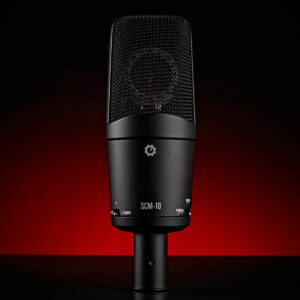 Cardioid, sometimes called unidirectional, takes in sound from the front of the capsule and drops off towards the sides, completely rejecting the rear. This is great for most front-facing recording, and very useful for live performance, as it helps to prevent feedback and bleed from other sound sources on noisy stages.
Cardioid, sometimes called unidirectional, takes in sound from the front of the capsule and drops off towards the sides, completely rejecting the rear. This is great for most front-facing recording, and very useful for live performance, as it helps to prevent feedback and bleed from other sound sources on noisy stages.
Cardioid is commonly seen in dynamic microphones, like the SZM-11 and Shure SM7dB, as well as high-end condensers like the G4M Studio Condenser, and Neumann TLM 102. It’s also frequently present in multi-pattern microphones.
The polar pattern is best used on vocals, acoustic guitars, guitar amps, snare drums, tom drums, and kick drums, both live and in the studio.
Supercardioid and hypercardioid
An exaggerated form of cardioid polar patterns, supercardioid and hypercardioid both strengthen side rejection in exchange for slight pickup from the rear. These are great in crowded recording situations, orchestras, large bands, small live stages, or recording full bands in a studio live room whilst preventing bleed and feedback.
This can shine on specific sources, giving the sound a sense of closeness. Supercardioid has a little bit of rear pickup and has some sensitivity on the sides, whilst hypercardioid almost completely rejects the sides and picks up more from the rear.
These polar patterns are best used on vocals, microphones like the G4M Dynamic Vocal Microphone and the Audio-Technica MB3K fill this purpose, giving performers the handheld convenience of popular mics whilst preventing feedback on smaller or busier stages.
Supercardioid and hypercardioid patterns can also be seen on mics for kick drums, orchestral strings, guitar amplifiers, acoustic guitars, percussion, or anything else that needs detail. You’ll often see these patterns on small-diaphragm condensers, multi-pattern microphones, and some handheld stage condensers to achieve a more polished, hi-fi sound on live vocals.
These patterns can also be incredibly useful in studios, offering more experimentation and a chance to really pull your audience’s ears towards key details that you want to place up front.
Omnidirectional
Omnidirectional is perhaps self-explanatory, in that it picks up all around it equally. This isn’t usually great for live performances as it’s extremely susceptible to ambient noise and instrument bleed, putting it at a high risk of feedback.
However, this weakness is also its strength. Omnidirectional mics can be useful for capturing ambient noise in controlled environments or placing multiple sources around a single mic, for example, acapella performances with multiple singers at once, or orchestral performances with a lot of different performers around. An omnidirectional mic can also help you pick out any details you want in field recordings.
As a result, omnidirectional mics are very situational and more of a studio-based tool, great for creating sound beds and ambiences to enhance performances. This is why they’re also ideal as room microphones, adding space and depth.
They’re useful for creative sound design, acoustic guitars, choirs, orchestras, and drum kits, and are also commonly used for film sound and dialogue recording, theatres and broadcasting, conferences, and interviews.
You’ll see this pattern on lavalier and headset microphones frequently. There aren’t many dedicated omnidirectional microphones, but you’ll often see it in multi-pattern microphones, such as the AKG P420.
Figure eight
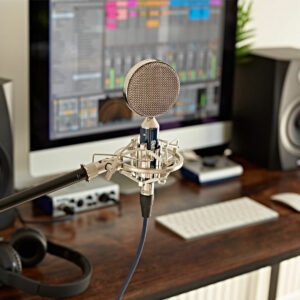 Figure eight, or bi-directional microphones, pick up equally from the front and back, whilst totally rejecting the sides. This is great for recording in stereo or picking up two sources at once whilst preventing pickup from other instruments at the sides.
Figure eight, or bi-directional microphones, pick up equally from the front and back, whilst totally rejecting the sides. This is great for recording in stereo or picking up two sources at once whilst preventing pickup from other instruments at the sides.
Many ribbon microphones, like the SubZero R1, have a figure eight polar pattern, as do many multi-pattern microphones.
Figure eight is situational, making it difficult to use in live performances, but it’s very useful in studios. It’s great for working with ensembles, capturing two vocalists at once, and can also be good at picking up some ambient noise whilst remaining focused on a source.
For example, instead of using a cardioid microphone and a room microphone separately, figure eight can pick up the source in front of it, as well as ambient room tone from the back. This creates a great sense of scale that can work extremely well on acoustic guitars and amps.
Although my favourite use of this pattern is putting a pair of the AKG C414 XLS on drum overheads in figure-eight mode – it sounds huge!
Shotgun
Shotgun microphones are in a slightly unique space, being defined by both a different physical design and polar pattern. Shotgun microphones can be either dynamic or condensers, but are built as a long barrel shape that extends forwards. This gives it a directionality that’s a lot like supercardioid but extends further forwards. It still keeps sensitivity from the sides at a minimum and has some slight pickup at the back of the capsule.
They’re often used in film, TV, broadcasting, and theatre. Boom microphones for dialogue recording are often shotgun microphones, as are many on-camera microphones. This also makes them good for content creation, with some compact designs being made to mount directly onto a camera, like the Rode Videomicro II.
Shotgun microphones have a very neutral, highly directional sound, and can also be used for foley recording in film post-production.
Multi-pattern
Multi-pattern microphones allow you to switch between multiple polar patterns. Depending on the microphone in question, it could be switchable from cardioid to supercardioid and back, or go through all of the above, with the exception of shotgun patterns. Some modern designs even allow you to morph between multiple existing polar patterns to create new and unique ones!
Multi-pattern microphones are almost always condensers. Large-diaphragm condensers tend to be the most common of these, with the AKG C414 XLS being one of the most famous examples. However, some pencil condensers, like the G4M Pencil Condenser Microphone, offer a range of switchable capsules with different polar patterns, which function similarly.
A recent form of multi-pattern mics is the modelling microphone like the Universal Audio Sphere LX – a neutral, flat, accurate mic that comes with software you can use to shape its sound and polar pattern to recreate rare, expensive, or vintage microphones commonly seen in studios. There are a few other similar models on the market too, and these can be a great value for money.
Multi-pattern microphones are great versatile tools for studio use and tend to be highly priced, being more of a centrepiece which could be used to record just about anything. However, this has changed in recent years, with new companies creating some very original multi-pattern designs that are priced at a good level for home studios.
Some even have more affordable variants that offer only one pattern or a smaller range of selectable patterns for achieving the mic’s recognisable sound signature for live use, home studios, and budget production.
Diaphragm sizes
There are three main sizes of diaphragm that we tend to use to sort between different types of condenser microphones: small, medium, and large.
Small diaphragm condensers are compact, typically pencil-shaped designs that have a very detailed and linear frequency response. This makes them great on acoustic instruments and they tend to be a go-to choice for acoustic guitars, pianos, drum overheads, and many orchestral instruments, like cellos, violins, and violas, as well as cymbals and percussion.
Despite their smaller size, small diaphragm condensers actually have better SPL handling and wider dynamic range than their larger counterparts, with a very good transient response, although their sensitivity and internal noise can be higher.
Large-diaphragm condensers are the classic visual of a high-end studio microphone. These microphones are extremely versatile and detailed. Their larger diaphragms tend to move more than the smaller ones, picking up and responding to more sonic detail from the source. This makes them studio centrepieces and well-suited to just about everything aside from close-miking drums.
The trade-off of this cleaner, detailed sound is poorer SPL handling. Whilst robust enough to not be damaged by louder sounds, their signals will tend to distort easily when placed too close to a loud sound.
Medium diaphragm condensers blend the characteristics of both large and small diaphragm condensers, having sensitivity and depth with some of the high-frequency detail from a smaller diaphragm. It’s a good middle ground, especially in terms of versatility, and is another good choice for starting a microphone collection.
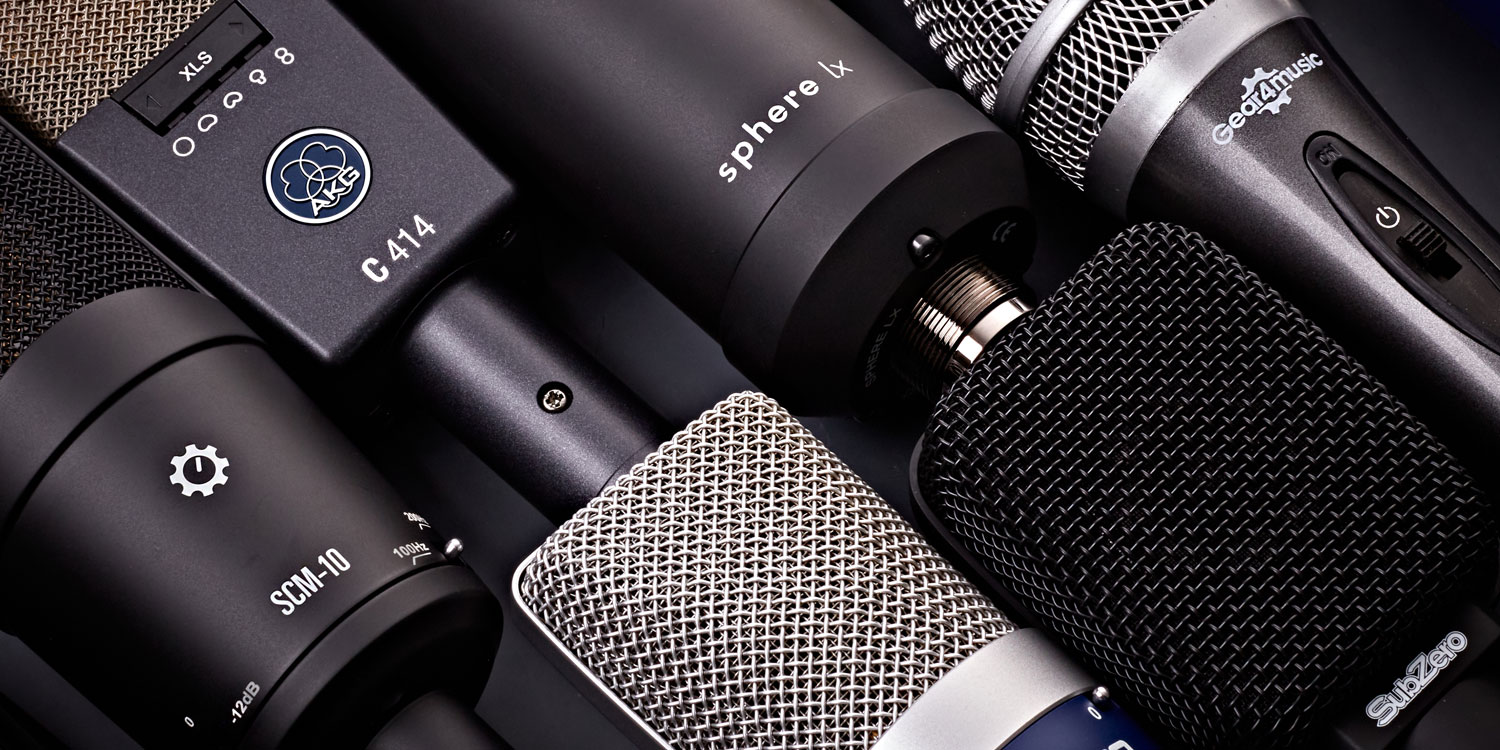
What is the proximity effect?
The proximity effect exaggerates the low-frequencies of a source when the microphone is placed closer to it. This has an effect on vocals, in particular, and is why we’ll often see vocalists or podcasters place themselves extremely close to the microphone they’re using. However, it does impact pretty much any source, and this can be an issue or used to your advantage.
It can be good to emphasise the low end of a guitar amp, for example. But if you place the microphone too close to the speaker cone, you may end up losing clarity and having a muddy guitar sound.
The proximity effect is why pop filters are important while vocal recording. Vocalists being close to the microphone can make sudden bursts of air when pronouncing plosives like “p” or “b” sounds, and this distorts an otherwise well-balanced signal. Pop shields prevent this, halting the sudden flow of air to smooth out the signal.
How to choose the right microphone
Choosing the right microphone really comes down to two things. First – where are you recording? Second – what are you recording? Just by answering these, we can get a good answer pretty easily.
For example, if you’re recording in a completely untreated room, you’re probably going to want a dynamic mic. This isn’t a hard rule, some condensers may do extremely well if your untreated room still sounds diffuse enough to not be a major problem. But generally, a dynamic is a safer choice starting out in untreated spaces.
This same reasoning is why dynamics tend to be a better choice for live performance. There may be a handful of dedicated instrument condensers on, say, guitar amps, drum cymbals, or drum overheads, but generally, you’ll probably be relying on dynamic mics on a stage due to their background noise rejection and SPL handling.
For vocalists, something like the SubZero SZM-11, G4M Dynamic Vocal Microphone, or Audio-Technica MB3K have that dark, gritty dynamic microphone sound, a unidirectional polar pattern, and excellent SPL handling under pressure. For live instruments, you’re looking at instrument dynamics like the SubZero GD100 or perhaps a small-diaphragm condenser like the SubZero Pencil Condenser Microphone Kit.
Content creation and podcasting also tend to rely on dynamic microphones. For this, we’d recommend a dynamic with a broadcast-inspired sound, like the Rode Podmic or the Shure SM7dB, which are both extremely popular choices for this form of content. That said, they’re also great for streamers or recording voiceovers for video content. You may also see top-range large diaphragm condensers for this sometimes.
If you’re not enamoured with that broadcast sound or want to sound a little different from the rest, a large-diaphragm condenser could be a good way to differentiate yourself. But with their sensitivity, they’re very susceptible to handling noise, and they’re not great for untreated recording spaces.
For studio recordings, you probably want a range of several mic types to layer up and blend, but I’d recommend having at least one good dynamic that can handle instruments, and a workhorse condenser. Something medium- or large-diaphragm with a multi-pattern design could really let you cover almost everything at least sufficiently.
Something like the SubZero SZC-800, AKG C414 XLS, or the Universal Audio Sphere LX would cover just about any sonic territory you wanted to go into. From there, it may be worth getting a pair of small-diaphragm condensers too.
For location recording and video content outdoors, you’ll want a shotgun mic.
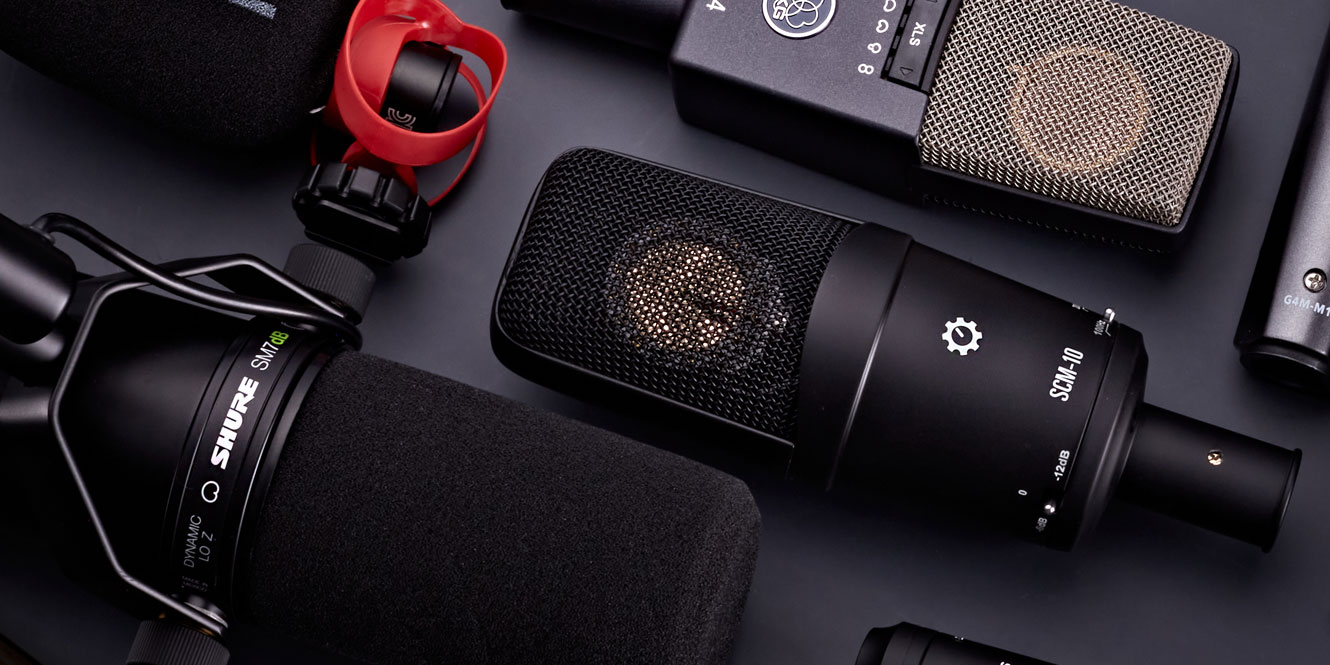
FAQs
What are the 4 common types of microphones?
The four main types of microphones are the following:
- Dynamic microphones
- Large-diaphragm condenser microphones
- Small-diaphragm condenser microphones
- Ribbon microphones
Which type of microphone is best?
Dynamic microphones are best for instruments and live vocals. Small-diaphragm condensers are best for recording instruments and vocals, both live and in the studio. Large-diaphragm condensers are best for studio recording, especially for vocals, but some instruments, like acoustic guitars, too, and ribbon microphones are great for choirs, orchestras, and guitars.
What are the four characteristics of every microphone?
The four main characteristics that affect microphone sound and performance are:
- Output level
- Frequency response
- Output impedance
- Directivity
Final thoughts
We’ve covered all the different types of microphones and how they work, from the electrical principles behind their capsule design to their polar patterns and what they’re best for. So whether you’re looking at something for the studio or the stage, hopefully, you’ve discovered which one is best for you and learned how and why it works the way it does!

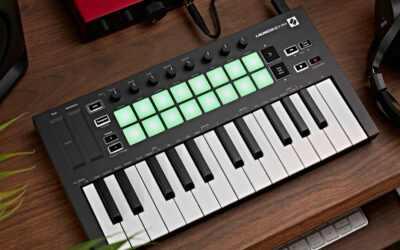
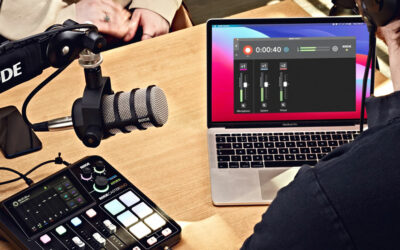
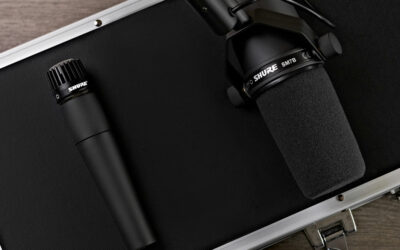

0 Comments